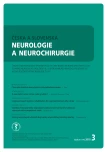Results of surgical treatment of unruptured brain arteriovenous malformations – monocentric retrospective study
Authors:
M. Bolcha; M. Sameš
Authors‘ workplace:
Neurochirurgická klinika, Univerzita J. E. Purkyně a Masarykova nemocnice Ústí nad Labem
Published in:
Cesk Slov Neurol N 2018; 81(3): 298-303
Category:
Original Paper
doi:
https://doi.org/10.14735/amcsnn2018298
Overview
The authors present a monocentric retrospective study of a group of 27 patients operated for non-ruptured brain arteriovenous malformation (AVM) during years 1999–2017. The aim was to compare our results with the results of larger international studies and to draw appropriate conclusions. All patients underwent radical resection of the AVM and their clinical status was evaluated using the modified Rankin scale before and after the surgery with an average 6-year follow-up. The group was represented by the AVM´s Spetzler-Martin Scale I–IV. After resection, six patients improved, one deteriorated, and the others remained in the same condition as before surgery. Our morbidity was 3.7 % and mortality was 0 %. After 16 years of follow-up, no recurrence or residual malformation were detected in any patient. Compared to foreign studies, our results for all types of AVM´s are comparable and, therefore, for the unruptured the AVM´s Spetzler-Martin I–II microsurgical approach, for the unruptured AVM´s Spetzler-Martin III microsurgical approach with possible complementary alternatives of embolization or radiotherapy and for the AVM´s Spetzler-Martin IV–V rather observation can be recommended.
Key words:
unruptured brain arteriovenous malformations – microsurgery – treatment outcome – Spetzler-Martin Scale
The authors declare they have no potential conflicts of interest concerning drugs, products, or services used in the study.
The Editorial Board declares that the manuscript met the ICMJE “uniform requirements” for biomedical papers.
Sources
1. Mohr JP, Parides MK, Stapf C et al. Medical management with or without interventional therapy for unruptured brain arteriovenous malformations (ARUBA): a multicentre, non-blinded, randomised trial. Lancet 2014; 383(9917): 614– 621. doi: 10.1016/ S0140-6736(13)62302-8.
2. Davidson AS, Morgan MK. How safe is arteriovenous malformation surgery? A prospective, observational study of surgery as first-line treatment for brain arteriovenous malformations. Neurosurgery 2010; 66(3): 498– 504. doi: 10.1227/ 01.NEU.0000365518.47684.98.
3. Stapf C, Mohr JP, Pile-Spellman J et al. Epidemiology and natural history of arteriovenous malformations. Neurosurg Focus 2001; 11(5): e1.
4. Ondra SL, Troupp H, George ED et al. The natural history of symptomatic arteriovenous malformations of the brain: a 24-year follow-up assessment. J Neurosurg 1990; 73(3): 387– 391.
5. Stapf C, Mast H, Sciacca RR et al. Predictors of hemorrhage in patients with untreated brain arteriovenous malformation. Neurology 2006; 66(9): 1350– 1355.
6. Morgan MK, Davidson AS, Assaad NN et al. Critical review of brain AVM surgery, surgical results and natural history in 2017. Acta Neurochir (Wien) 2017; 159(8): 1457– 1478. doi: 10.1007/ s00701-017-3217-x.
7. Bervini D, Morgan MK, Ritson EA et al. Surgery for arteriovenous malformations of the brain is better than conservative management for selected cases: a prospective cohort study. J Neurosurg 2014; 121(4): 878– 890. doi: 10.3171/ 2014.7.JNS132691.
8. Potts MB, Lau D, Abla AA et al. Current surgical results with low-grade brain arteriovenous malformations. J Neurosurg 2015; 122(4): 912– 920. doi: 10.3171/ 2014.12.JNS14938.
9. Steiger HJ, Fischer I, Rohn B et al. Microsurgical resection of Spetzler-Martin grades 1 and 2 unruptured brain arteriovenous malformations results in lower long-term morbidity and loss of quality-adjusted life-years (QALY) than conservative management – results of a single group series. Acta Neurochir (Wien) 2015; 157(8): 1279– 1287. doi: 10.1007/ s00701-015-2474-9.
10. Bradáč O. Chirurgická léčba arteriovenózní malformace. Cesk Slov Neurol N 2016; 79/ 112(6): 639– 643.
11. Burkhardt JK, Lasker GF, Winkler EA et al. Microsurgical resection of brain arteriovenous malformations in the elderly: outcomes analysis and risk stratification. J Neurosurg 2017; 22: 1–7. doi: 10.3171/ 2017.6.JNS17392.
12. Schramm J, Schaller K, Esche J et al. Microsurgery for cerebral arteriovenous malformations: subgroup outcomes in a consecutive series of 288 cases. J Neurosurg 2017; 126(4): 1056– 1063. doi: 10.3171/ 2016.4.JNS153017.
13. Bradac O, Charvat F, Benes V. Treatment for brain arteriovenous malformation in the 1998–2011 period and review of the literature. Acta Neurochir (Wien) 2013; 155(2): 199– 209. doi: 10.1007/ s00701-012-1572-1.
14. Spetzler RF, Wilson CB, Weinstein P et al. Normal perfusion pressure breakthrough theory. Clin Neurosurg 1978; 25: 651– 672.
15. Rangel-Castilla L, Spetzler RF, Nakaji P. Normal perfusion pressure breakthrough theory: a reappraisal after 35 years. Neurosurg Rev 2015; 38(3): 399– 404. doi: 10.1007/ s10143-014-0600-4.
16. Meling TR, Proust F, Gruber A et al. On apples, oranges, and ARUBA. Acta Neurochir (Wien) 2014; 156(9): 1775– 1779. doi: 10.1007/ s00701-014-2140-7.
17. van Beijnum J, van der Worp HB, Buis DR et al. Treatment of brain arteriovenous malformations: a systematic review and meta-analysis. JAMA 2011; 306(18): 2011– 2019. doi: 10.1001/ jama.2011.1632.
18. Cenzato M, Boccardi E, Beghi E et al. European consensus conference on unruptured brain AVMs treatment (Supported by EANS, ESMINT, EGKS, and SINCH). Acta Neurochir (Wien) 2017; 159(6): 1059– 1064. doi: 10.1007/ s00701-017-3154-8.
Labels
Paediatric neurology Neurosurgery NeurologyArticle was published in
Czech and Slovak Neurology and Neurosurgery

2018 Issue 3
- Memantine Eases Daily Life for Patients and Caregivers
- Metamizole at a Glance and in Practice – Effective Non-Opioid Analgesic for All Ages
- Memantine in Dementia Therapy – Current Findings and Possible Future Applications
- Metamizole vs. Tramadol in Postoperative Analgesia
- Hope Awakens with Early Diagnosis of Parkinson's Disease Based on Skin Odor
Most read in this issue
- Chronic inflammatory demyelinating polyradiculoneuropathy
- Factors affecting early diagnosis of amyotrophic lateral sclerosis
- Muscle biopsy in 10 key points
- Is essential tremor a disease or a syndrome?
